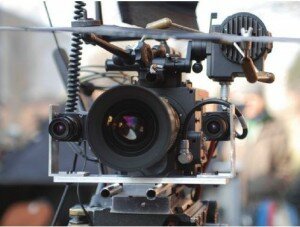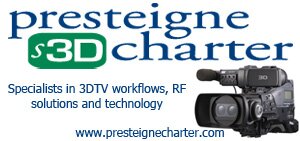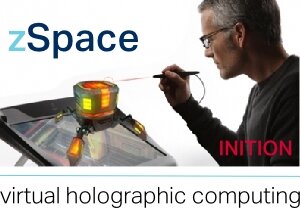Competition for glasses free 3D success intensifies
At IFA in Berlin, the Fraunhofer Institute for Telecommunications will be showcasing their real-time 3D to autostereoscopic 3D conversion technology, adding to a market that is becoming increasingly crowded and competitive.

During the same exhibition, Stream TV Networks will be revealing ‘mind-blowing’ technology that also includes enhancements to its own conversion technology called SeeCube.
The HHI researchers will demo how existing Blu-ray 3D content can be viewed on glasses free 3D displays by generating multiple viewpoints from just two left and right images via a 'depth map'.
“We take the existing two images and generate a depth map – that is to say, a map that assigns a specific distance from the camera to each object,” Christian Riechert, researcher at HHI, said in a press release. “From there we compute any of several intermediate views by applying depth image-based rendering techniques. And here’s the really neat thing: The process operates on a fully automated basis, and in real time.”
The algorithums are complete and the world famous institute are seeking partnerships with manufacturers to integrate them into products.
<
For glasses free 3D television to become a common-place reality, three core things have to happen. The displays (hardware) will need to be capable of showing full HD 3D images viewable by multiple people without any restrictions where they locate themselves to watch the screen (ie – the same 'relaxed' mode of watching regular 2D TV). The second core challenge is to generate video compatible on such displays. The most common technology used in existing auto-stereoscopic panels is lenticular and between 5 and 28 images need to be rendered (depending on manufacturer) per frame of video. Generating the extra angles can be achieved in a post production suite using tools such as Triaxes DepthGate.
Whilst high quality glasses free 3D content can be produced in this way, it means all existing and legacy two image 3D video will need to be converted. The ideal scenario is real-time conversion where a TV converts any side-by-side stereo footage from a 3D TV channel like Sky 3D or computer game on a PS3. The third challenge is, with broadcast still dominating the way most people consume video content, an efficient way of transmitting multi-view data needs to be established that does not require too much bandwidth.
Stream TV Networks claim to have solved the first problem. The Philedelphia based company have created glasses free 3D panels that can be viewed across a wide angle and without 'jumps' in the 3D effect when the viewer moves his or head ahead. They have achieved this via a new optical technology based on motion rather than lenticular panels used by most other companies. Stream TV Networks are looking to the home to expand and have joined forces with Chinese television maker Hisense to launch a 42-inch glasses free 3D TV.
Regarding the second challenge, there have been various attempts made at real-time conversion but achieving a good effect has been difficult, in a similar way to how televisions struggle to successfully convert 2D into 3D.
Triaxes are updating their NetJet (for real-time conversion) and DepthGate software (for post production conversion), which uses two depth maps rather than one and we can exclusively reveal the company is joining forces with Sisvel Technology at IBC in September to demo how the AS3D signal can be integrated into the Five Tile System – a 3D transmission format that can display 720P resolution video (unlike the half resolution of the side-by-side format), 2D video and glasses free 3D video in one broadcast stream.
Most auto-stereoscopic display manufacturers offer their own conversion tools too. Dimenco’s rendering solution, implemented as a flexible hardware engine, creates multiple views out of the 2D+Depth data structure suitable for any display. The Netherlands based company will be also be showing some new products at IFA this year. 3D Impact Media’s “Reality”-Tools are a tool-set for 3D post-production and conversion for glasses-based and glasses-free technologies. Tridelity also offer conversion services that fit into their 3D Content production pipeline between 3D content creation plug-ins and 3D Video Players.
Until real-time conversion reaches a high enough quality, new AS3D content is likely to be outputted into a 2D+Depth format in the post production stage as companies aim to get their conversion plug-ins integrate into existing software editing packages.
The debate will rage over whether artificially generating frames from two images will be true 3D and companies like NHK and MIT are working on glasses free 3D displays that offer true ‘look around’ 3D in the future (20 years in the future according to NHK). Shooting with 8 or more cameras will never be practical but one solution might be imcube's/FHI camera that shoots glasses free 3D content using just one lens, able to generate reliable depth maps on set.

The Fraunhofer Heinrich Hertz Institute have used the Trifocal Depth Capture system (pictured) and shared the obtained data with imcube who successfully utilised the extra information to adjust and improve the automatically estimated depth maps. When rendering virtual stereo or multi-views from the center camera, holes occur due to shifting pixels differently according to their depth information. These holes can be filled with the additional information from the satellite cameras.
imcube‘s Managing Director Dr. Sebastian Knorr said, “When we saw the results of HHI’s trifocal depth capture, we knew that this is the method of capture for the future. We also knew that the automatically estimated depth maps are not perfect but we have the tools to improve them. Thus, we started to develop a software framework and workflow that minimizes the manual workload of rotoscoping, depth assignment and in-painting which normally occurs in a conventional 2D-to-3D conversion process.”
Imcube are currently looking for partners to take the technology to the next stage.
Companies who can successfully address the three challenges outlined above are likley to have a bright future and the race is on to deliver the next evolution of television that can make watching 3D as normal as watching 2D; which is great news for all of us!
For more glasses free 3D news visit our dedicated glasses free 3D section.
FREE WEEKLY 3D NEWS BULLETIN –



















